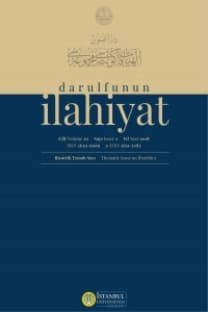Mehdi’yi Yeniden Tanımlamak: Senegalli Layeciler
Limamou Laye’nın (1844-1909) mehdilik iddiası ‘mehdi’ kavramının yeniden tanımlanmasına neden olmuştur. İslam
dünyasında mehdi kavramına yönelik farklı yaklaşımlar olmasına rağmen mehdinin Hz. Muhammed’in tekrar dünyaya gelmiş
hali oluşu (reincarnation) fikri ilk kez Limamou Laye tarafından gündeme getirmiştir. Sünni ve Şii gelenekleri temel alarak
mehdi kavramının tarihinden hareketle konuya yaklaşan bu makale Limamou Laye’nın mehdilik iddiasını araştırmaktadır.
Limamou Laye ismiyle tanınan Libasse Thiaw, 24 Mayıs 1883’te kendisinin mehdi ve Hz. Muhammed’in yeryüzüne yeniden
gelmiş hali olduğunu iddia etmiştir. Bu olayı tarihsel açıdan incelemek, İslami mehdi geleneğine bu yeni iddianın neden
eklendiği sorusunu gündeme getirmektedir. Bu sorunun cevabı, Libasse Thiaw’ın da mensup olduğu etnik grup olan Lebu’nun
tarihi ve coğrafi konumunda aranmalıdır. Bu noktada makale, Lebu’nun mehdi anlayışının şekillenmesinde üç kültürel etkinin
yardımcı olduğunu ileri sürmektedir. Bunlar; Lebu’nun geleneksel dini inanç sistemi, Senegal - Gambiya bölgesinde ifade
edildiği ve uygulandığı şekliyle İslam ve Fransızların bölgeye getirdiği Hristiyanlıktır
Anahtar Kelimeler:
Mehdi, Layeci (Layenne), Senegal, Limamou Laye, Lebu
Redefining al-Mahdi: The Layennes of Senegal
Limamou Laye (1844-1909) redefined the concept of the Mahdi with his proclamation. Though the concept of Mahdi
has a history of variations across the Islamic world, Limamou Laye added a previously unknown characteristic: Mahdi
as reincarnation of Muhammed. This article explores the history of the concept of the Mahdi focusing on the Sunni and
Shi’a traditions. On the 24 May 1883, Libasse Thiaw (later known as Limamou Laye) proclaimed himself the Mahdi. His
proclamation went on to say that he was the Prophet Muhammed returned to earth. Studying this event historically
begs the question, why was this particular detail added to an honored Islamic messianic tradition? The answer lies in the
history and geographical positioning of the Lebu, the ethnicity to which Libasse Thiaw belonged. I argue that three cultural
influences helped shaped the Lebu expression of the Mahdi. The first influence was the Lebu traditional religious belief
system. The second was Islam as expressed and practiced in the Senegambia. The third was the Christianity that the French
brought with them to the area.
Keywords:
Mahdi, Layennes, Senegal, Limamou Laye, Lebu,
___
- Armstrong, Karen. Islam: A Short History. New York: The Modern Library, 2002. Charles, Eunice. “Shaikh Amadu Ba and Jihad in Jolof.” The International Journal of African Historical Studies 8, no. 3 (1975): 367–382. Clarke, Peter. Mahdism in West Africa: The Ijebu Mahdiyya Movement. London: Luzac Oriental, 1996. Cleveland, William L. A History of the Modern Middle East. Boulder, Colorado: Westview Press, 1994. Diop, Cheikh Anta. Precolonial Black Africa. Translated by Harold Salemson. Chicago: Chicago Review Press, 1988. Diouf, Mamadou. Kajoor aux XIXe Siecle: Pouvoir ceddo et conquete colonial. Paris, France: Karthala, 1990. Duchemin, G. J. “La Republique Lebou et le peuplement actuel de La Presqu’ile du Cap- Vert.” Etudes senegalaises (IFAN) 1 (1949): 289–304. Dumez, Richard, and Moustapha Ka. Un village lebou dans la banlieue de Dakar. Paris: United Nations, 2000. Fisher, Humphrey. “The Early Life and Pilgrimage of al-Hajj Muhammad al-Amin the Soninke (d. 1877).” The Journal of African History 11, no.1 (1970): 51–69. Laborde, Cecile. La Confrierie Layenne et les Lebou du Senegal: Islam et culture traditionelle en Afrique. Bourdeaux: CEAN, 1995. Lovejoy, Paul, and J.S. Hogendorn. “Revolutionary Mahdism and the REsistance to Colonial Rule, 1905-1906.” The Journal of African History 31, no. 2 (1990): 217–244. Njeuma, Martin Z. “Adamawa and Mahdism: The Career of Hayatu ibn Sa’id in Adamawa, 18781898.” Journal of African History 12, no. 1 (1971): 61–77. Ross, Eric. “Christmas in Camberene, or How Muhammad Begets Jesus in Senegal.” In Muslims and Others in Sacred Places, edited by Margaret Cormack, 74–107. New York: Oxford University Press, 2013. doi:10.1093/acprof:oso/9780199925049.003.0004. Sarr, El Hajj Malik. Ajibou da Iyallah ou La vie exemplaire de Limamou Laye. Dakar: Imprimerie Nouvelle, 1966. Sylla, Assane. Les Prophetes Seydina Limamou Le Mahdi et Seydina Issa Rouhou Lahi. Dakar: Imprimerie Saint-Paul, 1989. Umar, Muhammad. “Muslims’ Eschatological Discourses on Colonialism in Northern Nigeria.” Journal of the American Academy of Religion 67, no. 1 (1999): 59–84. Willis, John R. “Jihad fi Sabil Allah- Its Doctrinal Basis in Islam and Some Aspects of its Evolution in Nineteenth Century West Africa.” The Journal of African History 8 (3): 395–415. Zempleni, Andras. “La dimension therapeutique du culte des rab Ndep Tuuru et Samp: Rites de possession chez les lebou et les wolofs.” Psychopathologie Africaine 2, no. 3 (1966): 289–439.
- Yayın Aralığı: Yılda 2 Sayı
- Başlangıç: 1925
- Yayıncı: İstanbul Üniversitesi İlahiyat Fakültesi
Sayıdaki Diğer Makaleler
Bir Osmanlı Tarihçisi: Osmân Fütûhî ve ʻAcâʼibü’l-Mehârib ve Garâʼibü’l-Meʻârik Adlı Eseri
Veysel GOGER, Huseyin SARİKAYA
Zekât ve Vakıf Bağlamında Yoksulluk, Açlık ve Eşitsizlik
Dil-Kur’ân-Anlam Üzerine Tefsire Metodolojik Bir Katkı -Ebüssenâ el-İsfahânî’nin Mukaddimesi-
Mehdi’yi Yeniden Tanımlamak: Senegalli Layeciler
Dil-Kur’ân-Anlam Üzerine Tefsire Metodolojik Bir Katkı -Ebüssenâ el-İsfahânî’nin Mukaddimesi
Mülk Suresinde Estetik: Metafizik Ayna Olarak Matematiksel Tipoloji
